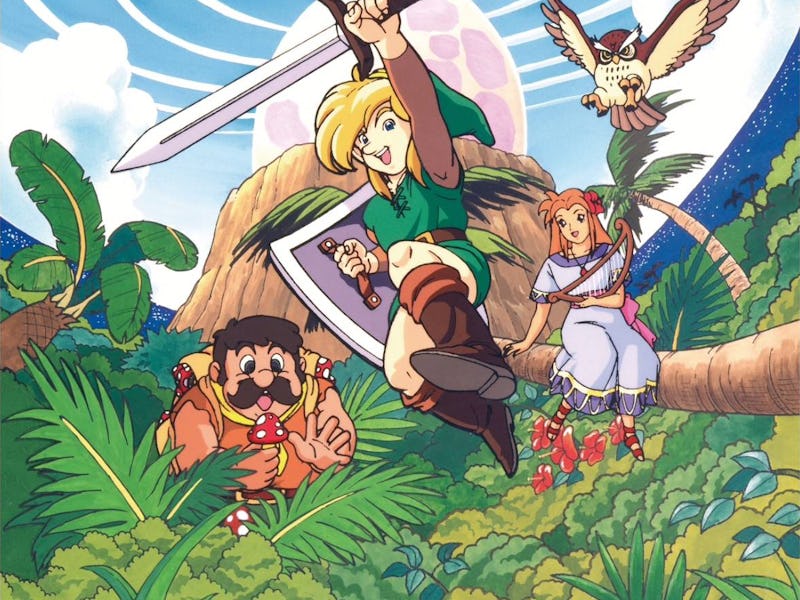Link’s Awakening DX Remains One of Nintendo’s Boldest and Best Experiments
It was all a dream...

The cult of Twin Peaks has been around for a long time. When the show debuted on ABC back in 1990, it stood out for being a crime show that didn’t really feel like a crime show. It felt larger than life and also communal, seemingly allergic to the heavy plot focus of other police procedurals. Sure, Special Agent Dale Cooper was collecting clues related to the case of Laura Palmer’s murder, but the show expanded into a world of characters, some of whom verged on the mystical.
Although steeped in Americana, the show’s decidedly off-kilter approach gathered international fans. Among them was Takashi Tezuka at Nintendo, who would eventually become the director of The Legend of Zelda: Link’s Awakening, the 1993 Game Boy game which is available right now if you’ve subscribed to Nintendo Switch Online + Expansion Pack.
This trailer may be for the 2019 remake, but the story remains the same after all these years.
Thinking back to what he wanted the series’ first handheld game to feel like, series producer Eiji Aonuma recalled in a Nintendo interview that Tezuka “wanted it to be like Twin Peaks, but characters that looked like Mario and Luigi were appearing.”
Tezuka made sure to add, “and Kirby.”
Link’s Awakening was a pivotal moment for Zelda games. Producers at Nintendo describe it as the first game in the series to have a complete plot, which they used to move Link away from familiar lands. Awakening is one of the rare Zelda games without its titular princess. The Triforce and Hyrule don’t appear in any capacity. Link’s Awakening makes Link a fish out of the water — somewhat literally as he’s shipwrecking on the mysterious and dreamlike Koholint Island.
Never let go, Link!
Fittingly, the game’s origins start with one of its smaller components: a fishing mini-game that can be found just north of the game’s starting point of Mabe Village. Fun fact: That fishing game was being made by programmer Kazuaki Morita before anyone at Nintendo was even thinking of making the game. He was just playing around with the Game Boy’s dev kit.
From there, the team at Nintendo EAD began to tinker with the idea of what a Zelda game for the Game Boy might look like. According to Tezuka, that gave the game’s initial development a feeling of “an after-school club activity.”
The relaxed atmosphere allowed for some fourth-wall breaks in Link’s Awakening, some jokes within a series that has often been known for its sweeping dramas. It incorporates characters from other games, like Kirbies and the adorable baby Chain Chomp named CiaoCiao. Islanders that Link meets, namely Tarin and a Henhouse Keeper, happen to look a lot like Mario and Luigi. A character named Mr. Write looks like a character from SimCity and spends his days writing to a faraway girlfriend named Christine who looks exactly like Princess Peach.
While the 2019 remake looks way better, it’s hard to beat these retro vibes.
These references are made with a light touch as Link focuses on uncovering the mysteries of the island. He collects his sword on a beach, explores a mysterious forest, and climbs a mountain range. The inhabitants are scared because Link’s crash into their home also brought along mysterious monsters, but they are happy and kind to Link. A witch even gives him some Magic Powder which can temporarily change an item or an enemy into something else.
The game’s dungeons often have an aquatic feel to them, like the Bottle Grotto and Angler’s Tunnel, in which appear the game’s memorable mini-bosses, the Hydrosoars. But the game’s most memorable enemies are undoubtedly Nightmares, which again play into the game’s dream-like themes.
The best Zelda game from this era is undoubtedly Link to the Past. But Link’s Awakening is a fun and clever game in its own right, breaking the series out of its familiar environs and successfully creating something new. It’s a game that rewards curiosity and has a sense of humor about itself, asking players to help change things in the world. With a much-expanded creator ability coming in Tears of the Kingdom, it’s fun to see how this type of gameplay worked itself into the legacy of one of gaming’s most storied franchises.